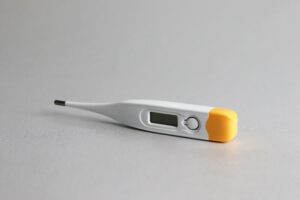Pelvic Inflammatory Disease: A Simple Guide


Pelvic Inflammatory Disease (PID) is an infection of the upper reproductive tract in females. This means it affects the uterus (including the endometrium), the fallopian tubes and the ovaries. PID usually results from a bacterial infection spreading upwards from the vagina and cervix.
The prevalence of PID is difficult to establish because many people have it without even realising; however, it is estimated that approximately 5% of women in the US will be treated for PID in their lifetime.
What causes PID?
The cause of PID is not always identified. One in four cases of PID are due to a sexually transmitted infection (STI). The three most likely to lead to PID are:
- Chlamydia. Approximately 1 in 10 women with untreated chlamydia will get PID within a year.
- Gonorrhoea.
- Mycoplasma genitalium.
PID can also occur when normal bacteria from the vagina passes to the upper structures of the reproductive system. This is more likely after:
- Damage to the cervix, for example, during childbirth or miscarriage.
- A procedure to open the cervix, such as inspection of the uterus or insertion of an IUD.
One of the difficulties in treating PID comes from the fact that multiple bacterial species may be contributing to the inflammation.
Who is most at risk?
One in five cases of PID in the US are thought to occur in women younger than 19. Women who are between 15 and 24 years old and sexually active are considered to be most at risk. The reasons for this are probably both biological and behavioural. Biologically, younger women have a larger surface area on which bacteria can attach and grow. Behaviourally, they are also more likely to have shorter term relationships, with multiple partners; when they do not use adequate contraception, they increase their risk of developing an STI.
What are the most common symptoms?
Often symptoms are minimal and mild. Some of the most common complaints are:
- Pain around the pelvis
- Dyspareunia
- Dysuria
- Bleeding between periods
- Heavy, painful periods
- Unusual vaginal discharge.
In severe cases, a woman with PID may experience high fever, intense pain and nausea or vomiting. This is rare, but if you are experiencing these symptoms you should seek medical assistance immediately as you might be at increased risk of suffering from long-term complications.
How is PID diagnosed and treated?
Diagnosing PID can be challenging, not least because the main symptoms, such as pain and abnormal uterine bleeding are not specific to this condition.
Your doctor will most likely take a detailed medical history and perform a pelvic examination in the first instance and then use both to make a diagnosis based on your symptoms. As the underlying cause of PID is an infection, swabs will usually be taken from the cervix and vagina. However, a negative result does not rule out PID.
Tests such as blood and urine tests and a transvaginal ultrasound can also be used to rule out alternative pathologies. Endometriosis and PID share a number of common symptoms, so your doctor may wish to rule that out first by performing a laparoscopy, to check for any endometrial deposits. In more severe cases of PID a laparoscopy can also be used to rule out appendicitis.
PID is treated using antibiotics, often a combination to target the different bacteria that can contribute to the infection. Treatment should start as quickly as possible, as delays in antibiotic therapy for PID have been associated with increased risk of complications. These will usually be given orally, but can be given intravenously in severe cases. Most of the time this is the only treatment that is required. If abscesses (painful accumulations of pus) have developed you may need to have them drained via laparoscopy.
Sexual partners from the 6 months before you noticed symptoms will also need to be tested and, if positive, treated to stop reinfection or PID spreading to others. PID can also occur in long-term relationships where neither partner has been sexually active with anyone else.
What are the complications of PID?
The most severe complications of PID are chronic pelvic pain, ectopic pregnancy and infertility. Ectopic pregnancy and infertility are a risk if persistent inflammation of the fallopian tubes causes them to become scarred and distorted. One in ten women with PID will struggle to conceive.
Most of the complications of PID are associated with recurrent disease. Recurrent disease affects approximately 21% of women with PID, and occurs when a female experiences multiple episodes. Those with recurrent disease are significantly more likely to experience chronic pain and infertility.
Recurrent disease usually happens when the initial infection is not adequately cleared. This is why your doctor will strongly encourage you to finish the prescribed dose of antibiotics, even if you no longer have symptoms. There is also a risk of reinfection by a partner if they have an untreated STI.
Practicing safe sex is the best way of protecting yourself against PID.
Nabta is reshaping women’s healthcare. We support women with their personal health journeys, from everyday wellbeing to the uniquely female experiences of fertility, pregnancy, and menopause.
Get in touch if you have any questions about this article or any aspect of women’s health. We’re here for you.
Sources:
- Peipert, Jeffrey F. “Genital Chlamydial Infections.” New England Journal of Medicine, vol. 349, no. 25, 18 Dec. 2003, pp. 2424–2430., doi:10.1056/nejmcp030542.
- “Pelvic Inflammatory Disease.” NHS Choices, NHS, www.nhs.uk/conditions/pelvic-inflammatory-disease-pid/.
- Trent, Maria, et al. “Pelvic Inflammatory Disease: Improving Awareness, Prevention, and Treatment.” Infection and Drug Resistance, vol. 9, 19 Aug. 2016, pp. 191–197., doi:10.2147/idr.s91260.










































